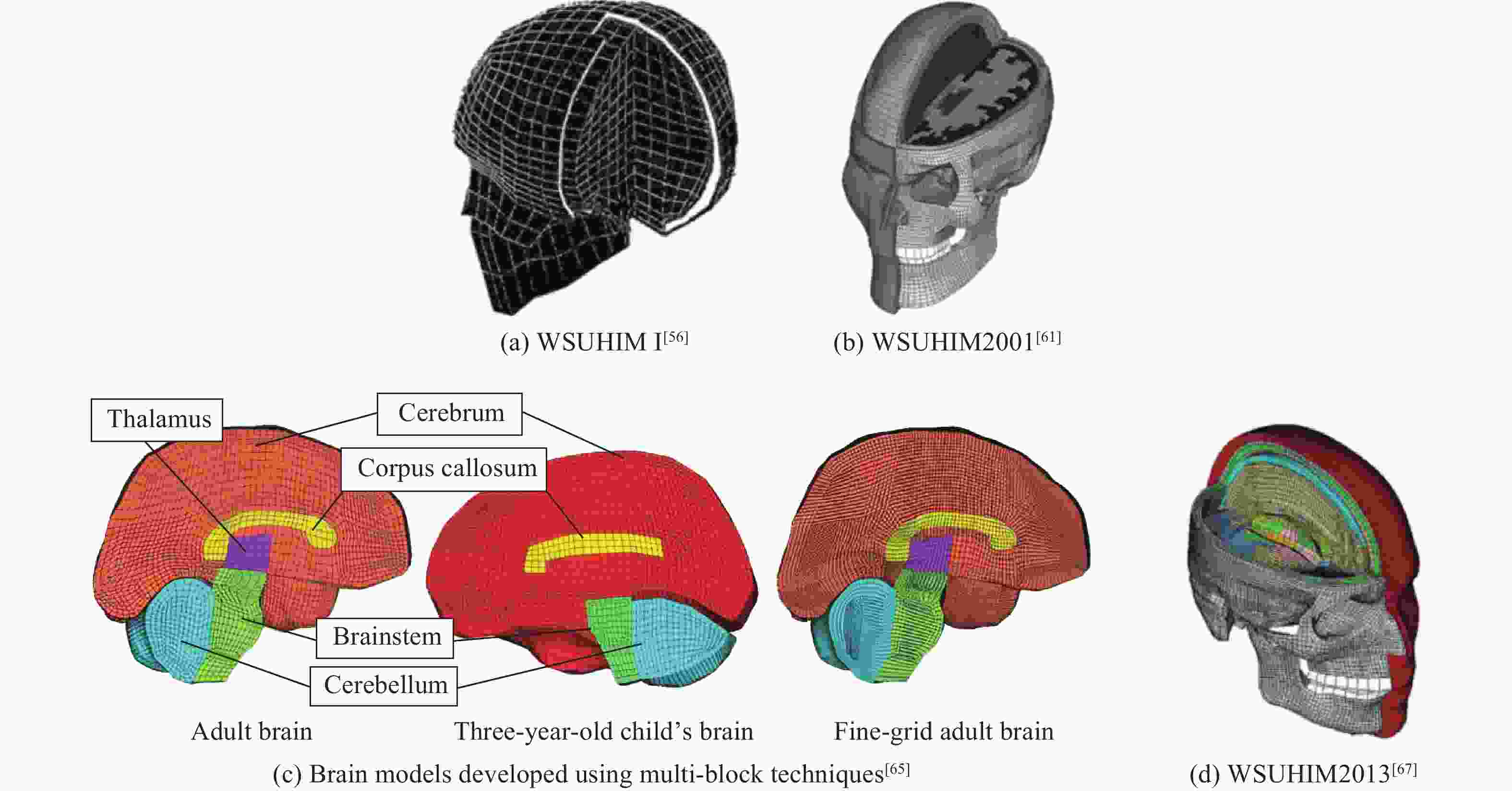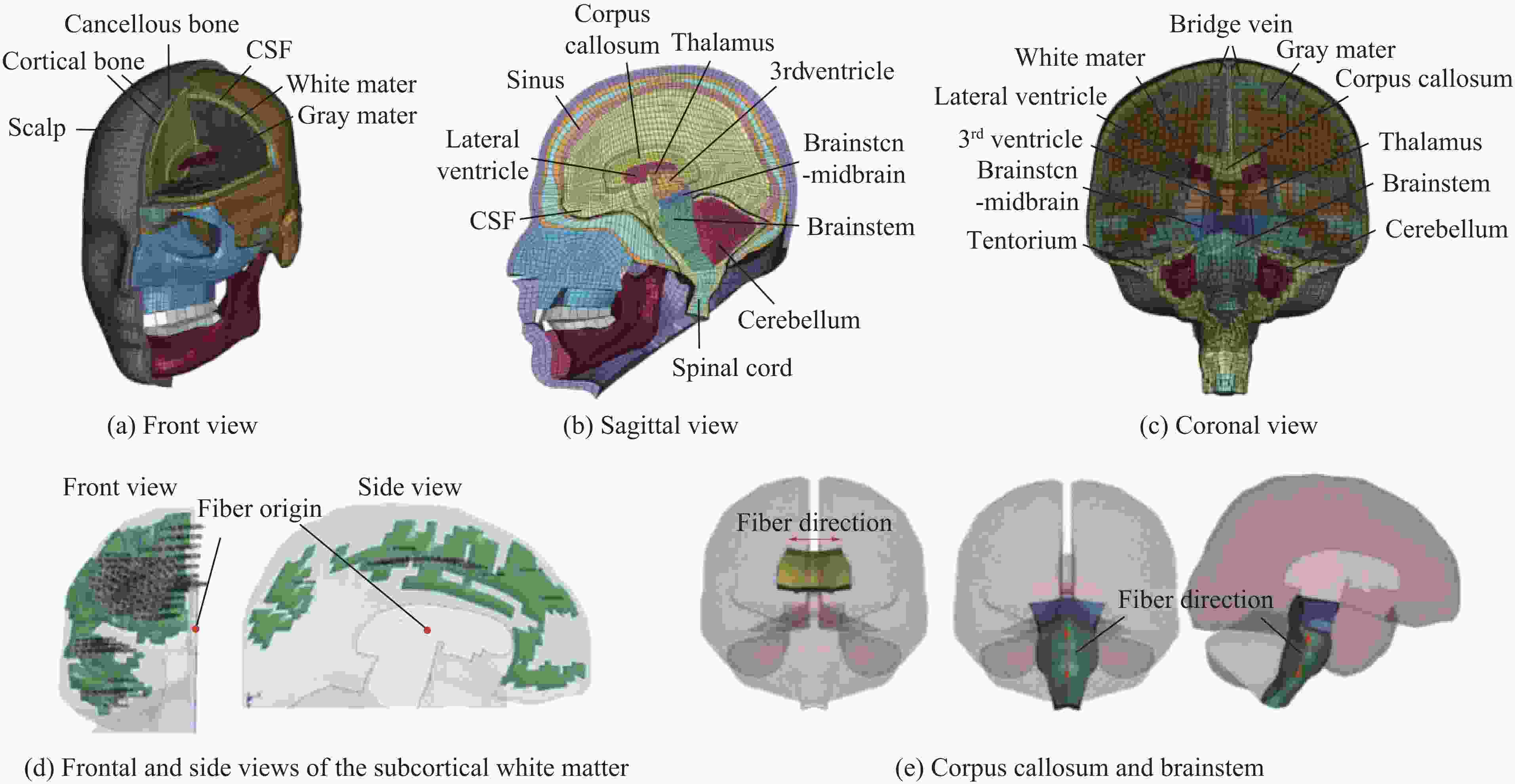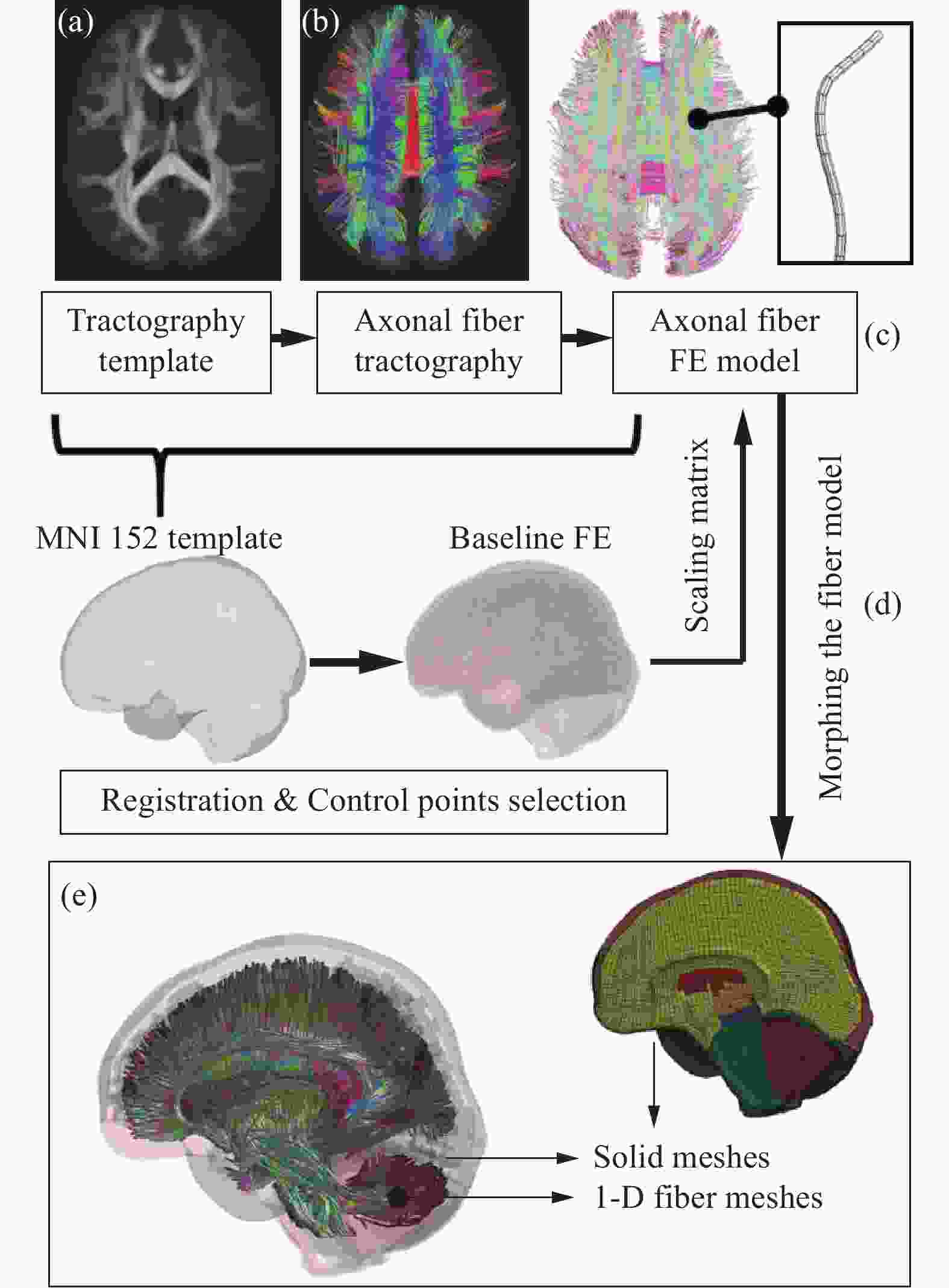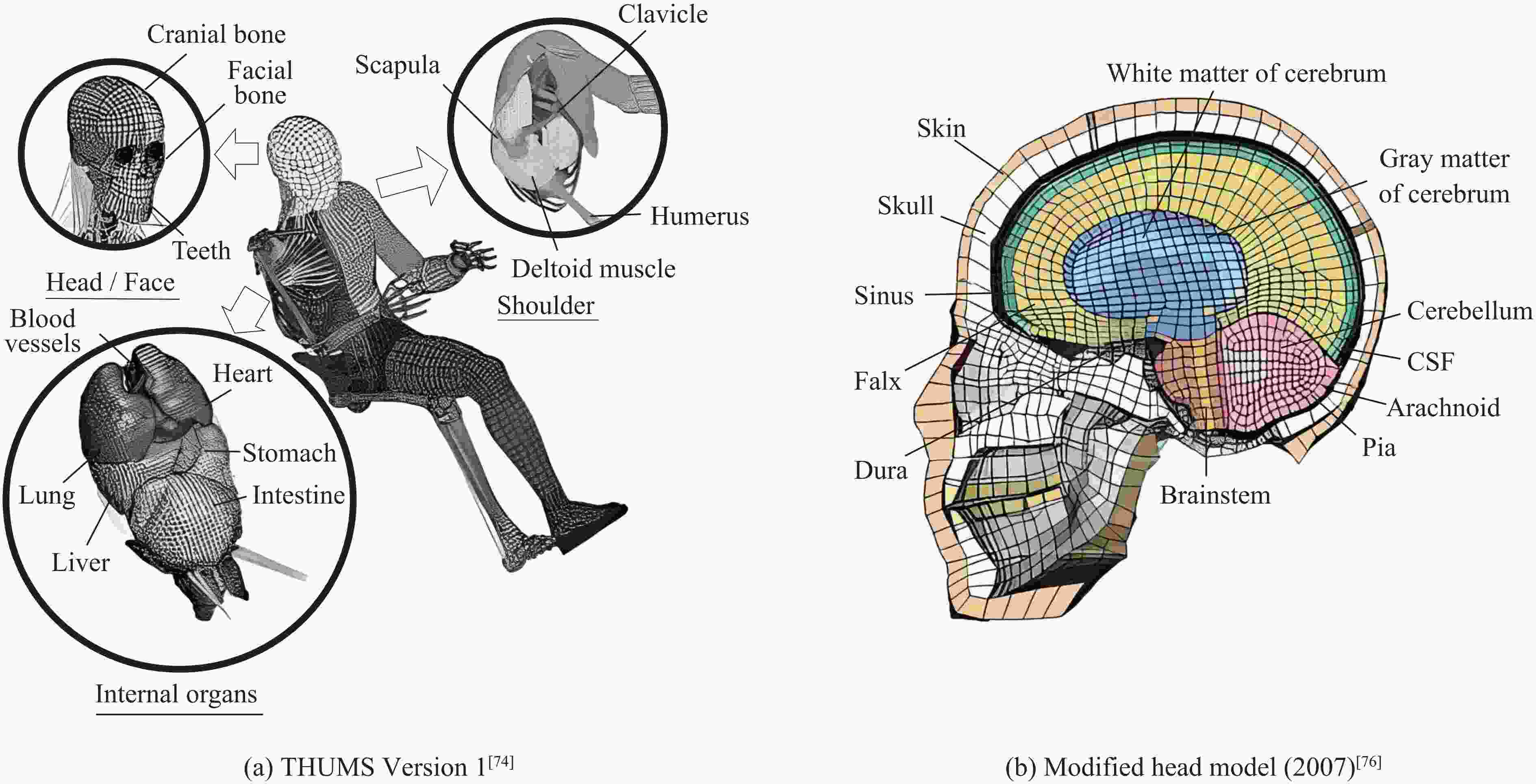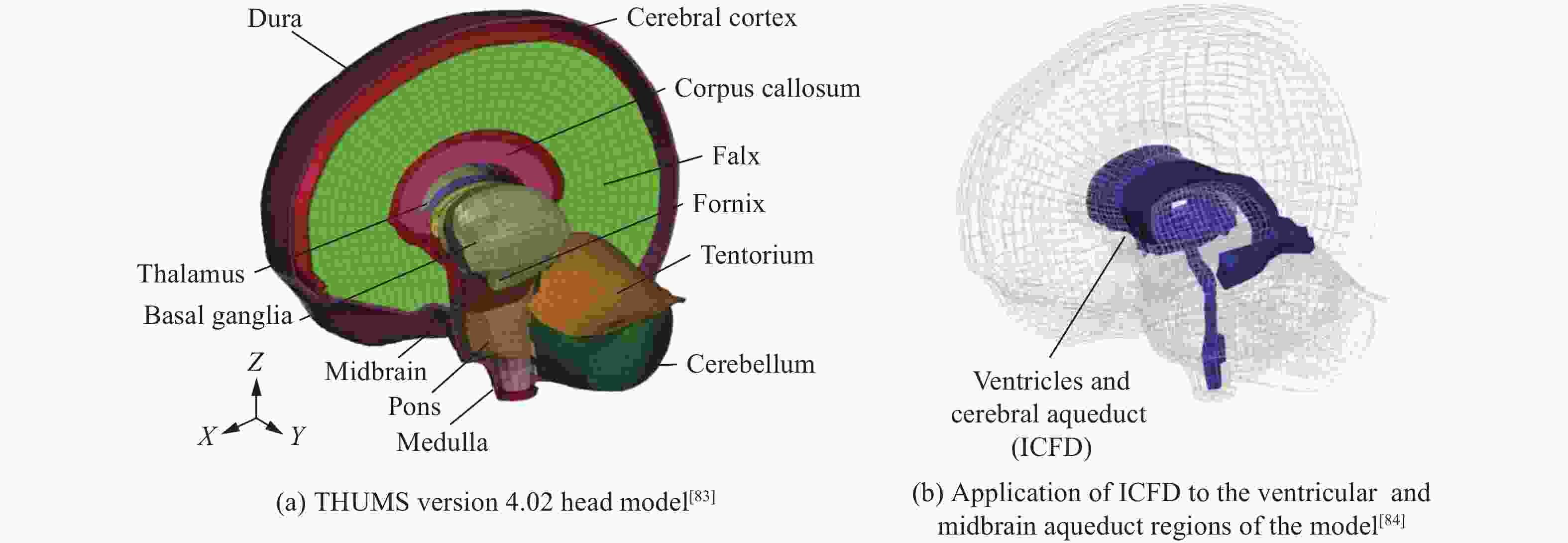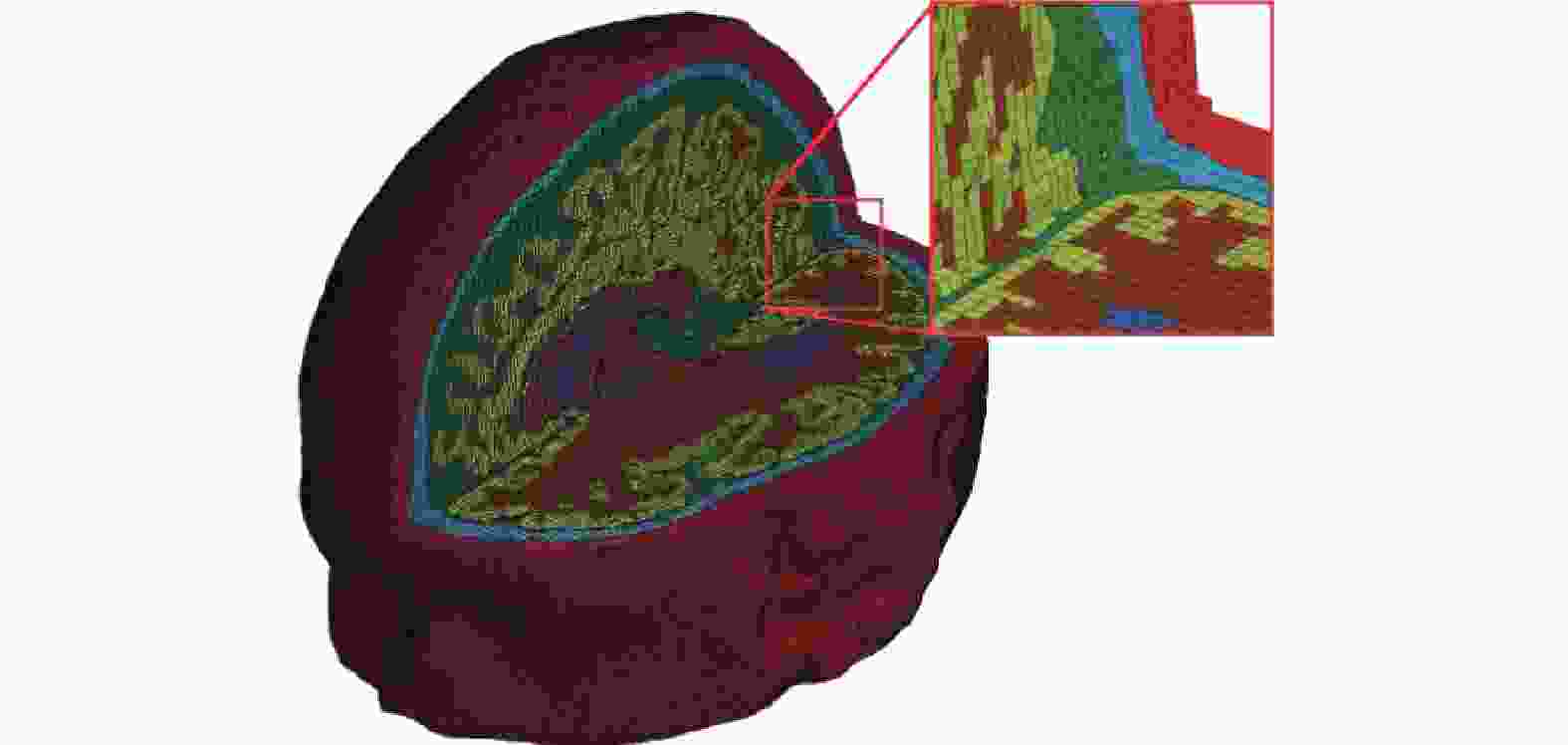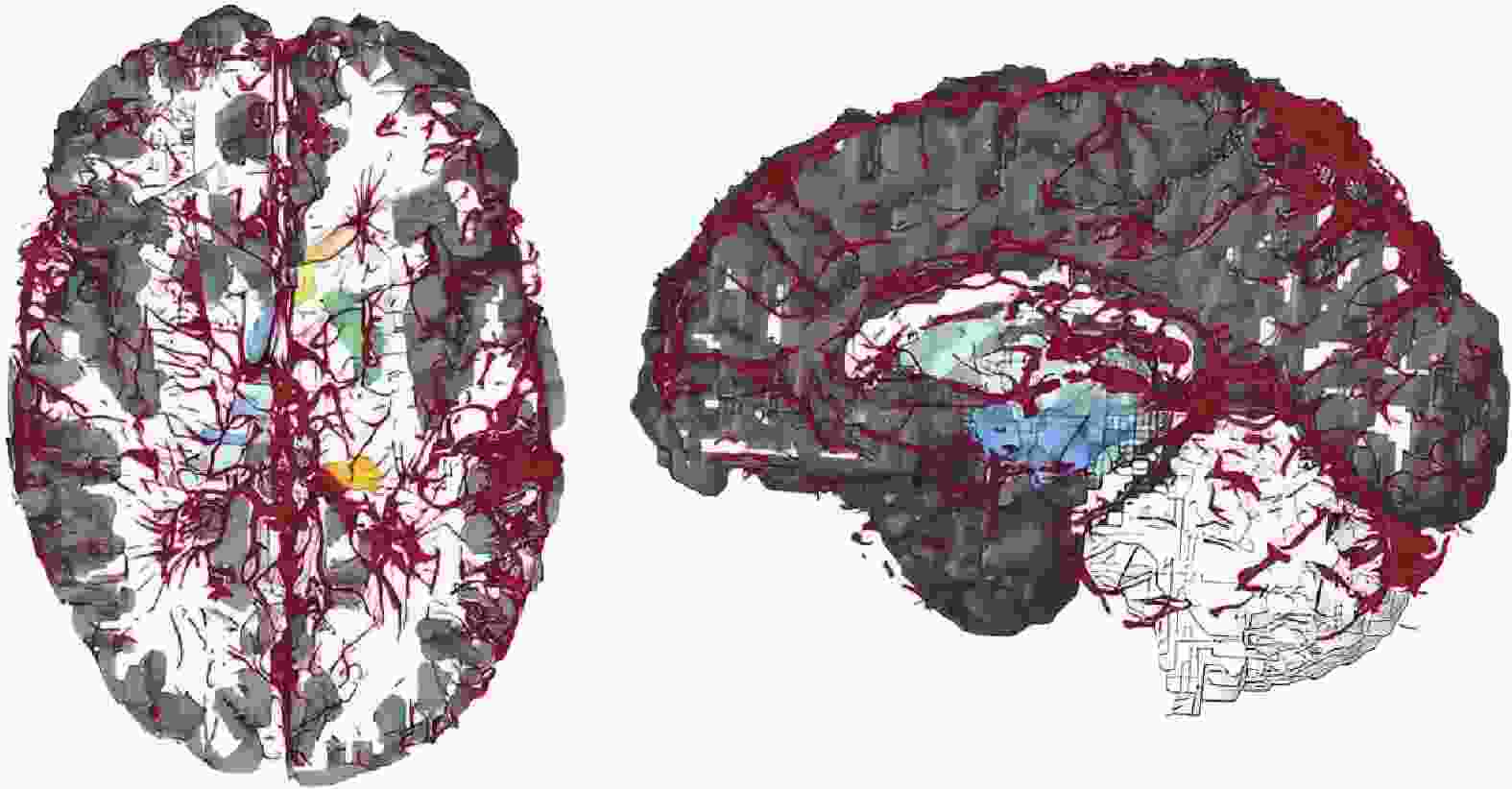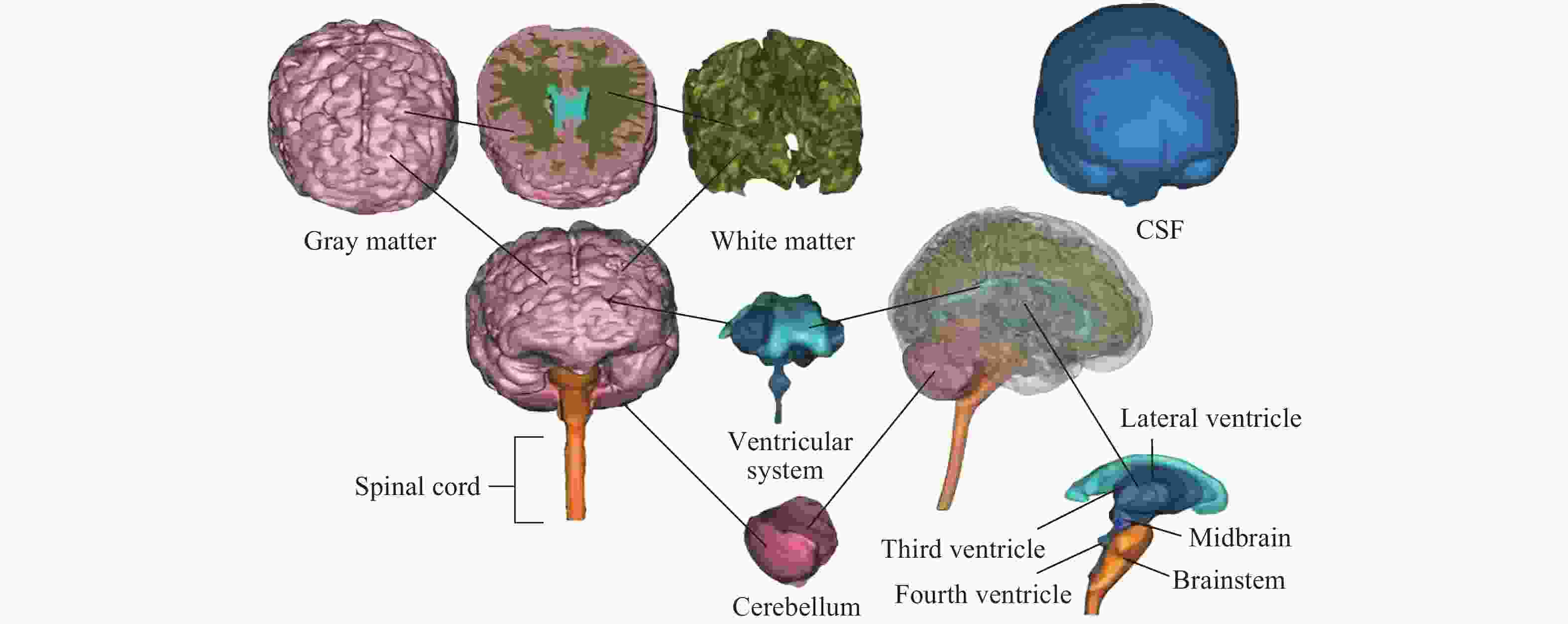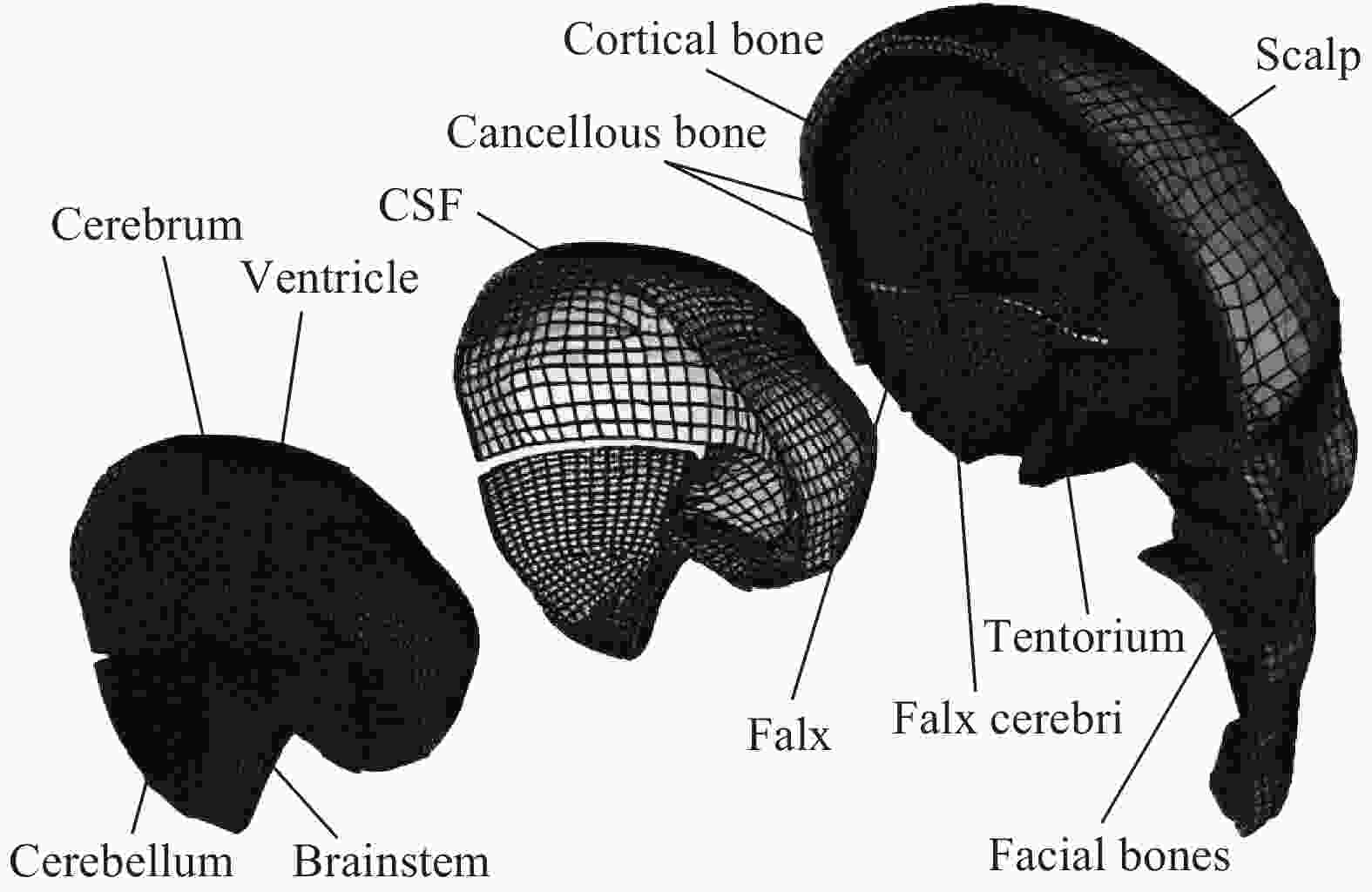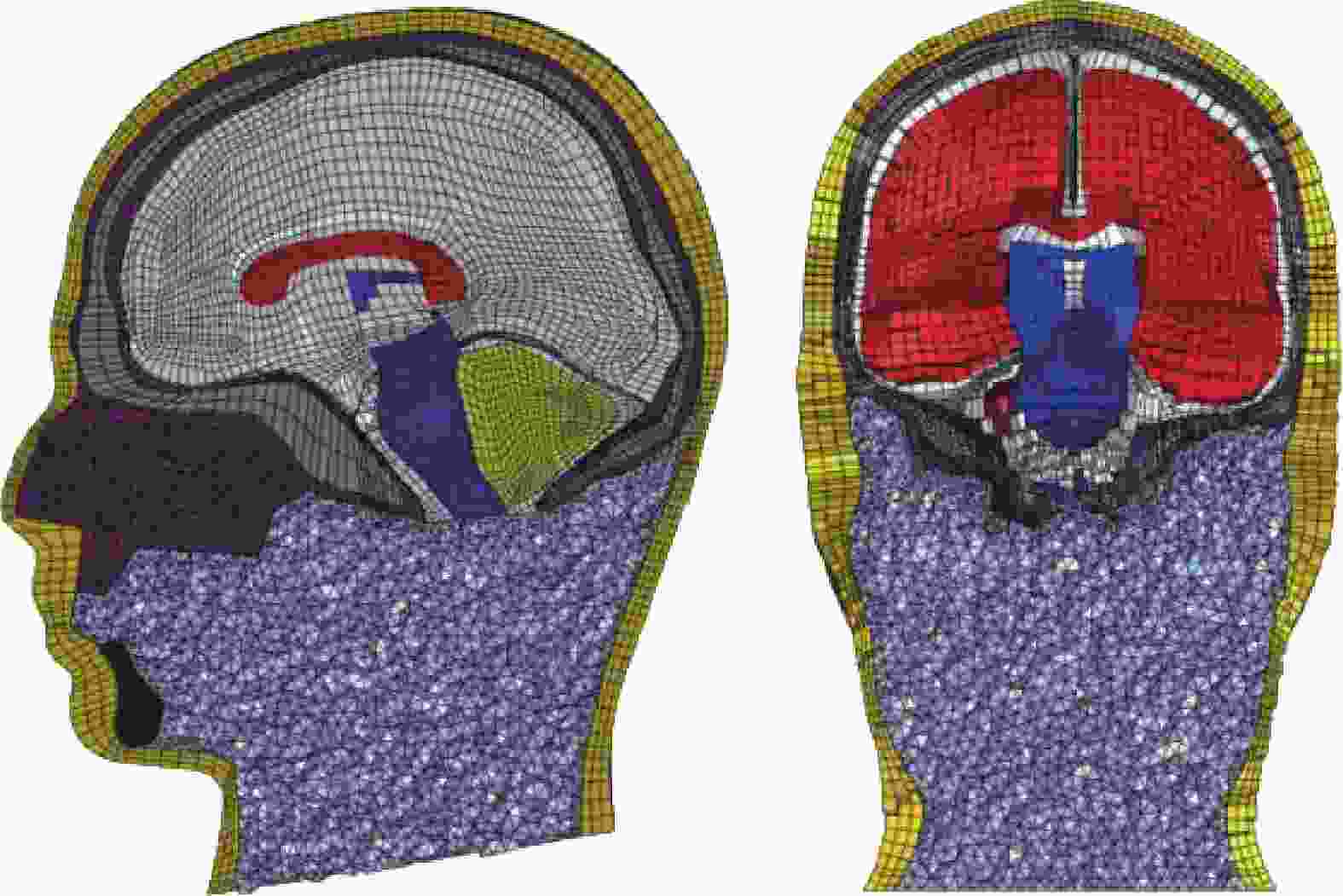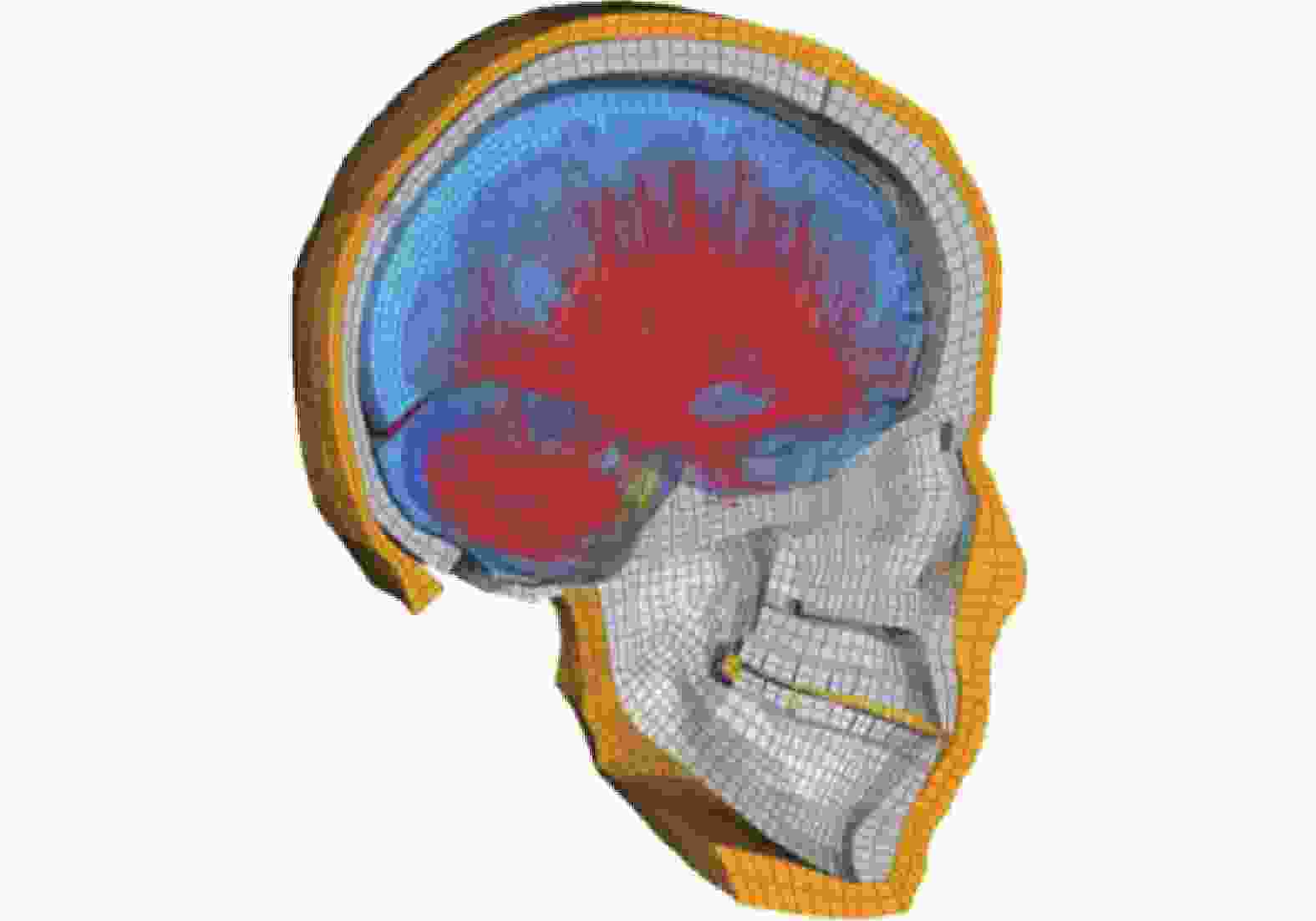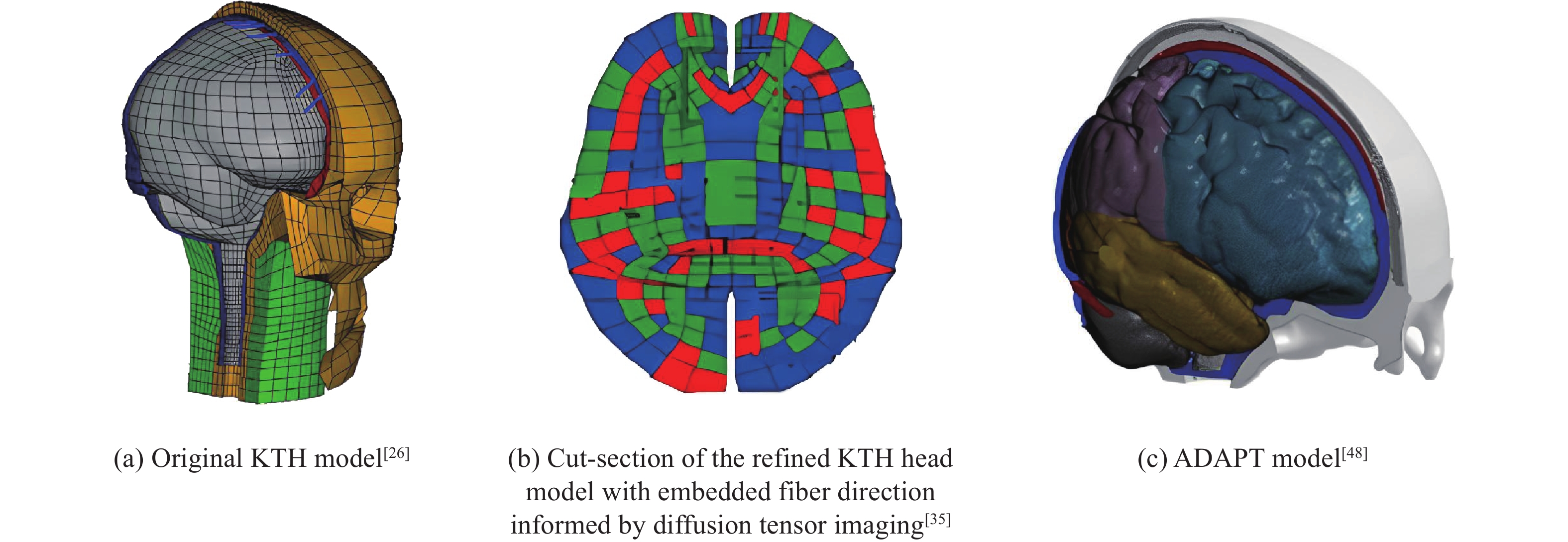Advances in finite element models of the human head for traumatic brain injury research
-
摘要: 创伤性脑损伤(traumatic brain injury, TBI)是发病率、患病率最高的神经系统疾病,为全社会带来了巨大的公共卫生负担。深入研究TBI的生物力学原理有助于提升头部防护效果,发展快速评估技术并采取及时干预,从而降低伤情恶化的风险。人类头部有限元模型(finite element head model, FEHM)作为一种数值分析工具,能够模拟头部在受到冲击时的动态响应,包括脑组织的应力应变时空分布、颅内压的变化等,为理解创伤性脑损伤的力学机制提供了重要依据。本文详细总结了国内外主流的人类头部有限元模型的现状与发展,追溯了模型的发展历程,总结了模型的特点并介绍了基于有限元模型的TBI机制研究进展。对相关研究的总结和梳理将有助于开发新型FEHM,并为创伤性脑损伤的风险评估及防护装备的设计提供理论指导和技术支撑。Abstract: Traumatic brain injury (TBI) is the neurological disorder with the highest incidence and prevalence, and poses a huge public health burden for the whole society. An in-depth study of the biomechanics of TBI can help to improve the effectiveness of head protection, develop rapid assessment techniques and take timely interventions, thus reducing the risk of injury deterioration. As a numerical analysis tool, the finite element head model (FEHM) is able to simulate the dynamic response of the head during impact, including the spatial and temporal distribution of stress-strain in brain tissues, and the change of intracranial pressure, which provides an important basis for understanding the mechanical mechanism of TBI. This paper summarizes in detail the current status and development of mainstream finite element models of the human head at home and abroad, traces the development of the models, summarises the characteristics of the models and introduces the research progress of TBI mechanisms based on finite element models. The summary and sorting out of related research will be helpful for the development of new FEHMs and provide theoretical guidance and technical support for the risk assessment of traumatic brain injury and the design of protective equipment.
-
表 1 人类头部有限元模型汇总
Table 1. Summary of finite element models of the human head
模型名称 作者 年份 模型描述 网格数量 颅脑接触定义 适用场景 KTH模型 Kleiven等[26] 2002 开发了KTH模型的原始版本,包括头皮、颅骨、大脑、脑膜、脑脊液(CSF)
以及11对矢状旁桥静脉18 416 固定接触(颅骨-硬脑膜);允许切向滑动接触(脑-软脑膜) 运动损伤监测、头盔护具设计及TBI机制研究 Ho等[29] 2007 提取了主要动静脉血管的几何形状,
将脉管系统合并到KTH模型中/ Giordano等[35] 2014 使用各向异性的超粘弹性纤维增强各向异性模型来描述脑组织的力学行为 / Zhou等[41] 2019 使用流固耦合方法(FSI)修改了初始KTH模型中的脑-颅骨界面 增加了CSF单元 Li等[48] 2021 增加了大脑皮层表面的沟回结构,
并在结构中嵌入了白质(WM)纤维束,
实现 CSF层与脑室系统的贯通4 400 000个六面体单元和540 000个四面体单元 共节点连接 WSUHIM模型/
GHBMC头部
模型Ruan等[56] 1993 开发了WSUHIM模型的原始版本,
具有头皮、三层颅骨、脑脊液(CSF)、
硬脑膜、大脑镰和大脑7 351 / 交通安全、体育运动损伤及TBI机制研究 Zhou[57] 1995 细化网格,补充灰质、白质、脑室
等解剖细节,定义非均质大脑22 995 / Al-Bsharat等[59] 1999 引入颅骨和大脑表面的滑动接触界面 / 滑动接触 Zhang等[61] 2001 网格更精细,能够模拟高加速度下的
直接和间接冲击响应314 500 无分离滑动接触 Mao等[67] 2013 使用多块技术建立了新的模型,具有
头皮、颅骨和面部骨骼、鼻窦、大脑、
小脑、侧脑室、胼胝体、丘脑和脑干
等结构,后集成于GHBMC人体模型270 552 固定接触 Wu等[69] 2019 将白质轴突成分嵌入模型 82 083 / Lyu等[72] 2022 采用各向异性黏-超弹性材料模型
定义大脑组织246 829 / THUMS
头部模型Iwamoto等[74] 2000 仅由颅面部骨骼、韧带和肌肉组成 固定接触 交通安全、汽车碰撞实验以及TBI预测 Iwamoto等[76] 2007 区分了皮质骨和松质骨,其余结构
包括大脑、小脑、脑干以及脑脊液
(CSF)、硬脑膜、软脑膜、蛛网膜、
大脑镰和小脑幕等49 700 Iwamoto等[79] 2015 消除了颅骨和大脑间的间隙,
修改固定接触为共节点连接共节点连接 Atsumi等[82] 2018 补充了深部脑区(胼胝体、边缘系统等)的解剖细节,采用具有各向异性、应变率依赖性及卸载特定的本构模型 62 048 Atsumi等[83] 2021 对脑脊液应用不可压缩流体动力学
控制方程61 345 IC模型 Ghajari等[87] 2017 模型包括头皮、颅骨、大脑、脑膜、
蛛网膜下腔和脑室等结构,特别地,
补充了大脑表面的脑沟结构~1 000 000个六面体单元和250 000个
四边形单元头部在碰撞中
的生物力学响应
及TBI机制研究Duckworth等[93] 2022 将头部静脉系统纳入模型 1 206 173 共节点连接 WHIM模型 Ji等[96] 2014 包括大脑、小脑、脑干、大脑镰、小脑幕、胼胝体等重要脑部解剖结构 115 228 共节点连接 体育运动安全、
脑部血管损伤
及TBI机制研究Zhao等[99] 2019 建立了各向异性大脑模型 143 300 Zhao等[100] 2020 将脉管系统合并到模型中 202 800 Zhao等[102] 2022 使用基于MRE得到的大脑异质性
材料特性定义大脑202 800 ULP模型 Willinger等[103] 1995 模型包括颅骨、脑脊液、大脑半球、
小脑、脑干和脑膜等结构6 213 允许3个自由度的运动(沿x和y轴的平移以及绕z轴的旋转) 事故重建、
法医学研究
及TBI机制研究Kang等[105] 1997 修改后的模型包括皮肤、颅骨、面部、大脑、小脑、硬脑膜、蛛网膜下腔、大脑镰和小脑幕等结构;除了大脑是黏弹性材料,其余结构均定义为均匀且各向同性 13 208 Deck等[107] 2004 针对颅骨皮质骨和松质骨选用了不同的材料参数,整体模型采用弹塑性材料模型 74 243 UCDBTM模型 Horgan等[115] 2003 模型包括头皮、三层头骨、硬脑膜、
脑脊液、软脑膜、大脑镰、小脑幕、
大脑半球、小脑和脑干等结构9000 /25000 /50000 实体单元连接 运动损伤、
头盔护具性能评估
及TBI机制研究Yan等[118] 2011 定义脑组织为黏弹性,将脑脊液
模拟为静水流体/ 脑脊液层允许与固体结构相互作用 Trotta等[119] 2020 更新了头部多个部件的力学性能,
在头皮和颅骨之间引入低摩擦系数,
细化了模型的网格184 261 头部的重心及3个沿x/y/z轴2.5 cm处的点被直接约束到颅骨 图斯特头部
模型包永涛等[133] 2010 模型包括大脑、小脑、脑干、脑室、
脑脊液、硬脑膜、软脑膜、大脑镰、
小脑幕以及颅骨的内外骨板
和板障等主要头部结构89 510 更符合中国人特征的保护装置的设计分析、人体运动学和生物力学响应
及损伤机理研究HBM头部模型 Yang[138] 2011 模型包括头皮、颅骨、硬脑膜、脑脊液(CSF)、软脑膜、大脑、小脑、脑室、
脑干、大脑镰、小脑幕等解剖结构61 121 滑动接触 车辆碰撞中的颅脑
损伤及潜在的损伤
机制研究用于bTBI研究的头部模型 Li等[141] 2019 模型包括大脑、小脑、脑干、侧脑室、
第三脑室、脑膜、脑脊液及具有典型
三明治结构的颅骨、皮肤和颈部303 588 自由边界 爆炸冲击波所致的
颅脑损伤研究注:如无特殊说明,以上网格数量统计均为不同单元数量之和。 -
[1] MAAS A I R, MENON D K, MANLEY G T, et al. Traumatic brain injury: progress and challenges in prevention, clinical care, and research [J]. The Lancet Neurology, 2022, 21(11): 1004–1060. DOI: 10.1016/S1474-4422(22)00309-X. [2] WILSON L, STEWART W, DAMS-O’CONNOR K, et al. The chronic and evolving neurological consequences of traumatic brain injury [J]. The Lancet Neurology, 2017, 16(10): 813–825. DOI: 10.1016/S1474-4422(17)30279-X. [3] HOOFIEN D, GILBOA A, VAKIL E, et al. Traumatic brain injury (TBI) 10–20 years later: a comprehensive outcome study of psychiatric symptomatology, cognitive abilities and psychosocial functioning [J]. Brain Injury, 2001, 15(3): 189–209. DOI: 10.1080/026990501300005659. [4] HAWRYLUK G W, MANLEY G T. Classification of traumatic brain injury: past, present, and future [J]. Handbook of clinical neurology, 2015, 127: 15–21. DOI: 10.1016/B978-0-444-52892-6.00002-7. [5] TSE K M, LIM S, TAN V B C, et al. A review of head injury and finite element head models [J]. American Journal of Engineering, Technology and Society, 2014, 1: 28–52. [6] GREVE M W, ZINK B J. Pathophysiology of traumatic brain injury [J]. Mount Sinai Journal of Medicine: A Journal of Translational and Personalized Medicine, 2009, 76(2): 97–104. DOI: 10.1002/msj.20104. [7] ZHAN X H, OEUR A, LIU Y Z, et al. Translational models of mild traumatic brain injury tissue biomechanics [J]. Current Opinion in Biomedical Engineering, 2022, 24: 100422. DOI: 10.1016/j.cobme.2022.100422. [8] SMITH D H, MEANEY D F, SHULL W H. Diffuse axonal injury in head trauma [J]. The Journal of Head Trauma Rehabilitation, 2003, 18(4): 307. DOI: 10.1097/00001199-200307000-00003. [9] GRAHAM N S N, JOLLY A, ZIMMERMAN K, et al. Diffuse axonal injury predicts neurodegeneration after moderate-severe traumatic brain injury [J]. Brain, 2020, 143(12): 3685–3698. DOI: 10.1093/brain/awaa316. [10] HARDY W N, FOSTER C D, MASON M J, et al. Investigation of head injury mechanisms using neutral density technology and high-speed biplanar X-ray [J]. Stapp Car Crash Journal, 2001, 45: 337–368. DOI: 10.4271/2001-22-0016. [11] NAHUM A M, SMITH R, WARD C C. Intracranial pressure dynamics during head impact: SAE Technical Paper 770922 [R]. Warrendale: SAE International, 1977. DOI: 10.4271/770922. [12] ALSHAREEF A, GIUDICE J S, FORMAN J, et al. Biomechanics of the human brain during dynamic rotation of the head [J]. Journal of Neurotrauma, 2020, 37(13): 1546–1555. DOI: 10.1089/neu.2019.6847. [13] ZHOU Z, LI X G, LIU Y Z, et al. Brain strain rate response: addressing computational ambiguity and experimental data for model validation [J]. Brain Multiphysics, 2023, 4: 100073. DOI: 10.1016/j.brain.2023.100073. [14] GUETTLER A J, RAMACHANDRA R, BOLTE J, et al. Kinematics response of the PMHS brain to rotational loading of the head: development of experimental methods and analysis of preliminary data: SAE Technical Paper 2018-01-0547 [R]. SAE Technical Paper, 2018. DOI: 10.4271/2018-01-0547. [15] ZHOU Z, LI X G, KLEIVEN S, et al. Brain strain from motion of sparse markers [C]//Proceedings of the 63rd Stapp Car Crash Conference. SAE, 2020. DOI: 10.4271/2019-22-0001. [16] DIXIT P, LIU G R. A review on recent development of finite element models for head injury simulations [J]. Archives of Computational Methods in Engineering, 2017, 24(4): 979–1031. DOI: 10.1007/s11831-016-9196-x. [17] TAJRAN J, GOSMAN A A. Anatomy, head and neck, scalp [M]. Treasure Island (FL): StatPearls Publishing LLC., 2024. [18] ORR T J, LESHA E, KRAMER A H, et al. Traumatic brain injury: a comprehensive review of biomechanics and molecular pathophysiology [J]. World Neurosurgery, 2024, 185: 74–88. DOI: 10.1016/j.wneu.2024.01.084. [19] RUAN J, PRASAD P. The effects of skull thickness variations on human head dynamic impact responses [J]. Stapp Car Crash Journal, 2001, 45: 395–414. DOI: 10.4271/2001-22-0018. [20] MEANEY D F, OLVEY S, GENNARELLI T. Biomechanical basis of traumatic brain injury [J]. Youmans and Winn Neurological Surgery, 2016, 4: 2755–2764. DOI: 10.1016/b978-1-4160-5316-3.00328-2. [21] KEATING C E, CULLEN D K. Mechanosensation in traumatic brain injury [J]. Neurobiology of Disease, 2021, 148: 105210. DOI: 10.1016/j.nbd.2020.105210. [22] JIN X, YANG K H, KING A I. Mechanical properties of bovine pia-arachnoid complex in shear [J]. Journal of Biomechanics, 2011, 44(3): 467–474. DOI: 10.1016/j.jbiomech.2010.09.035. [23] YANG S C, TANG J S, NIE B B, et al. Assessment of brain injury characterization and influence of modeling approaches [J]. Scientific Reports, 2022, 12(1): 13597. DOI: 10.1038/s41598-022-16713-2. [24] LÜDERS E, STEINMETZ H, JÄNCKE L. Brain size and grey matter volume in the healthy human brain [J]. NeuroReport, 2002, 13(17): 2371. DOI: 10.1097/00001756-200212030-00040. [25] 康越, 马天, 黄献聪, 等. 颅脑爆炸伤数值模拟研究进展: 建模、力学机制及防护 [J]. 爆炸与冲击, 2023, 43(6): 3–38. DOI: 10.11883/bzycj-2022-0521.KANG Y, MA T, HUANG X C, et al. Advances in numerical simulation of blast-induced traumatic brain injury: modeling, mechanical mechanism and protection [J]. Explosion and Shock Waves, 2023, 43(6): 3–38. DOI: 10.11883/bzycj-2022-0521. [26] KLEIVEN S, HARDY W N. Correlation of an FE model of the human head with local brain motion: consequences for injury prediction [J]. Stapp Car Crash Journal, 2002, 46: 123–144. DOI: 10.4271/2002-22-0007. [27] KLEIVEN S. Predictors for traumatic brain injuries evaluated through accident reconstructions [J]. Stapp Car Crash Journal, 2007, 51: 81–114. DOI: 10.4271/2007-22-0003. [28] KING A I, HARDY W N, MASON M J, et al. Comparison of relative motion between the brain and skull of the human cadaver for rotation in the coronal and sagittal planes [C]//Proceedings of the 4th World Congress of Biomechanics. 2002. [29] HO J, KLEIVEN S. Dynamic response of the brain with vasculature: a three-dimensional computational study [J]. Journal of Biomechanics, 2007, 40(13): 3006–3012. DOI: 10.1016/j.jbiomech.2007.02.011. [30] YANG K H, MAO H J, WAGNER C, et al. Modeling of the brain for injury prevention [M]//BILSTON L E. Neural Tissue Biomechanics. Berlin, Heidelberg: Springer, 2011: 69–120. DOI: 10.1007/8415_2010_62. [31] WALSH D R, ZHOU Z, LI X G, et al. Mechanical properties of the cranial meninges: a systematic review [J]. Journal of Neurotrauma, 2021, 38(13): 1748–1761. DOI: 10.1089/neu.2020.7288. [32] HO J, ZHOU Z, LI X G, et al. The peculiar properties of the falx and tentorium in brain injury biomechanics [J]. Journal of Biomechanics, 2017, 60: 243–247. DOI: 10.1016/j.jbiomech.2017.06.023. [33] HERNANDEZ F, GIORDANO C, GOUBRAN M, et al. Lateral impacts correlate with falx cerebri displacement and corpus callosum trauma in sports-related concussions [J]. Biomechanics and modeling in mechanobiology, 2019, 18(3): 631–649. DOI: 10.1007/s10237-018-01106-0. [34] COLGAN N C, GILCHRIST M D, CURRAN K M. Applying DTI white matter orientations to finite element head models to examine diffuse TBI under high rotational accelerations [J]. Progress in Biophysics and Molecular Biology, 2010, 103(2): 304–309. DOI: 10.1016/j.pbiomolbio.2010.09.008. [35] GIORDANO C, CLOOTS R J H, VAN DOMMELEN J A W, et al. The influence of anisotropy on brain injury prediction [J]. Journal of Biomechanics, 2014, 47(5): 1052–1059. DOI: 10.1016/j.jbiomech.2013.12.036. [36] BANDAK F A, VANDER VORST M J, STUHMILLER L M, et al. An imaging-based computational and experimental study of skull fracture: finite element model development [J]. Journal of Neurotrauma, 1995, 12(4): 679–688. DOI: 10.1089/neu.1995.12.679. [37] CLOOTS R J H, VAN DOMMELEN J A W, KLEIVEN S, et al. Multi-scale mechanics of traumatic brain injury: predicting axonal strains from head loads [J]. Biomechanics and Modeling in Mechanobiology, 2013, 12(1): 137–150. DOI: 10.1007/s10237-012-0387-6. [38] GIORDANO C, KLEIVEN S. Evaluation of axonal strain as a predictor for mild traumatic brain injuries using finite element modeling [J]. Stapp Car Crash Journal, 2014, 58: 29–61. DOI: 10.4271/2014-22-0002. [39] ZHOU Z, OLSSON C, GASSER T C, et al. The white matter fiber tract deforms most in the perpendicular direction during in vivo volunteer impacts [J]. Journal of Neurotrauma, 2024. DOI: 10.1089/neu.2024.0183. [40] ZHOU Z, LI X G, LIU Y Z, et al. Toward a comprehensive delineation of white matter tract-related deformation [J]. Journal of Neurotrauma, 2021, 38(23): 3260–3278. DOI: 10.1089/neu.2021.0195. [41] ZHOU Z, LI X G, KLEIVEN S. Fluid-structure interaction simulation of the brain-skull interface for acute subdural haematoma prediction [J]. Biomechanics and Modeling in Mechanobiology, 2019, 18(1): 155–173. DOI: 10.1007/s10237-018-1074-z. [42] ZHOU Z, LI X G, KLEIVEN S. Biomechanics of acute subdural hematoma in the elderly: a fluid-structure interaction study [J]. Journal of Neurotrauma, 2019, 36(13): 2099–2108. DOI: 10.1089/neu.2018.6143. [43] ZHOU Z, LI X G, KLEIVEN S. Evaluation of brain-skull interface modelling approaches on the prediction of acute subdural hematoma in the elderly [J]. Journal of Biomechanics, 2020, 105: 109787. DOI: 10.1016/j.jbiomech.2020.109787. [44] ZHOU Z, LI X G, KLEIVEN S. Biomechanics of periventricular injury [J]. Journal of Neurotrauma, 2020, 37(8): 1074–1090. DOI: 10.1089/neu.2019.6634. [45] ZHOU Z, LI X G, DOMEL A G, et al. The presence of the temporal horn exacerbates the vulnerability of hippocampus during head impacts [J]. Frontiers in Bioengineering and Biotechnology, 2022, 10: 754344. DOI: 10.3389/fbioe.2022.754344. [46] HO J, KLEIVEN S. Can sulci protect the brain from traumatic injury? [J]. Journal of Biomechanics, 2009, 42(13): 2074–2080. DOI: 10.1016/j.jbiomech.2009.06.051. [47] CLOOTS R J H, GERVAISE H M T, VAN DOMMELEN J A W, et al. Biomechanics of traumatic brain injury: influences of the morphologic heterogeneities of the cerebral cortex [J]. Annals of Biomedical Engineering, 2008, 36(7): 1203–1215. DOI: 10.1007/s10439-008-9510-3. [48] LI X G, ZHOU Z, KLEIVEN S. An anatomically detailed and personalizable head injury model: significance of brain and white matter tract morphological variability on strain [J]. Biomechanics and Modeling in Mechanobiology, 2021, 20(2): 403–431. DOI: 10.1007/s10237-020-01391-8. [49] LI X G. Subject-specific head model generation by mesh morphing: a personalization framework and its applications [J]. Frontiers in Bioengineering and Biotechnology, 2021, 9: 706566. DOI: 10.3389/fbioe.2021.706566. [50] O’KEEFFE E, KELLY E, LIU Y Z, et al. Dynamic blood–brain barrier regulation in mild traumatic brain injury [J]. Journal of Neurotrauma, 2020, 37(2): 347–356. DOI: 10.1089/neu.2019.6483. [51] CECCHI N J, DOMEL A G, LIU Y Z, et al. Identifying factors associated with head impact kinematics and brain strain in high school american football via instrumented mouthguards [J]. Annals of Biomedical Engineering, 2021, 49(10): 2814–2826. DOI: 10.1007/s10439-021-02853-5. [52] ZHAN X H, LI Y H, LIU Y Z, et al. The relationship between brain injury criteria and brain strain across different types of head impacts can be different [J]. Journal of the Royal Society Interface, 2021, 18(179): 20210260. DOI: 10.1098/rsif.2021.0260. [53] CECCHI N J, CALLAN A A, WATSON L P, et al. Padded helmet shell covers in American football: a comprehensive laboratory evaluation with preliminary on-field findings [J]. Annals of Biomedical Engineering, 2024, 52(10): 2703–2716. DOI: 10.1007/s10439-023-03169-2. [54] FANTON M, SGANGA J, CAMARILLO D B. Vulnerable locations on the head to brain injury and implications for helmet design [J]. Journal of Biomechanical Engineering, 2019, 141(12): 121002. DOI: 10.1115/1.4044876. [55] LAKSARI K, WU L C, KURT M, et al. Resonance of human brain under head acceleration [J]. Journal of The Royal Society Interface, 2015, 12(108): 20150331. DOI: 10.1098/rsif.2015.0331. [56] RUAN J S, KHALIL T B, KING A I. Finite element modeling of direct head impact: SAE Technical Paper 933114 [R]. Warrendale: SAE, 1993. DOI: 10.4271/933114. [57] ZHOU C, KHALIL T B, KING A I. A new model comparing impact responses of the homogeneous and inhomogeneous human brain: SAE Technical Paper 952714 [R]. Warrendale: SAE Transactions, 1995: 2999−3015. DOI: 10.4271/952714. [58] ROSS D T, MEANEY D F, SABOL M K, et al. Distribution of forebrain diffuse axonal injury following inertial closed head injury in miniature swine [J]. Experimental Neurology, 1994, 126(2): 291–298. DOI: 10.1006/exnr.1994.1067. [59] AL-BSHARAT A S, HARDY W N, YANG K H, et al. Brain/skull relative displacement magnitude due to blunt head impact: new experimental data and model: SAE Technical Paper 99SC22 [R]. Warrendale: SAE International, 1999. DOI: 10.4271/99SC22. [60] GURDJIAN E S, LISSNER H R. The position and motions of the head at impact: SAE Technical Paper 640847 [R]. Warrendale: SAE International, 1964. DOI: 10.4271/640847. [61] ZHANG L Y, YANG K H, DWARAMPUDI R, et al. Recent advances in brain injury research: a new human head model development and validation [J]. Stapp Car Crash Journal, 2001, 45: 369–394. DOI: 10.4271/2001-22-0017. [62] TROSSEILLE X, TARRIÉRE C, LAVASTE F, et al. Development of a F. E. M. of the human head according to a specific test protocol: SAE Technical Paper 922527 [R]. Warrendale: SAE International, 1992. DOI: 10.4271/922527. [63] FREDRIKSSON R, ZHANG L Y, BOSTRÖM O, et al. Influence of impact speed on head and brain injury outcome in vulnerable road user impacts to the car hood: SAE Technical Paper 2007-22-0007 [R]. Warrendale: SAE International, 2007. DOI: 10.4271/2007-22-0007. [64] VIANO D C, CASSON I R, PELLMAN E J, et al. Concussion in professional football: brain responses by finite element analysis: part 9 [J]. Neurosurgery, 2005, 57(5): 891–916. DOI: 10.1227/01.NEU.0000186950.54075.3B. [65] MAO H J, GAO H T, CAO L B, et al. Development of high-quality hexahedral human brain meshes using feature-based multi-block approach [J]. Computer Methods in Biomechanics and Biomedical Engineering, 2013, 16(3): 271–279. DOI: 10.1080/10255842.2011.617005. [66] ZHOU S Z, ZHANG X, MA H L. Numerical simulation of human head impact using the material point method [J]. International Journal of Computational Methods, 2013, 10(4): 1350014. DOI: 10.1142/S021987621350014X. [67] MAO H J, ZHANG L Y, JIANG B H, et al. Development of a finite element human head model partially validated with thirty five experimental cases [J]. Journal of Biomechanical Engineering, 2013, 135(11): 111002. DOI: 10.1115/1.4025101. [68] BIAN K W, MAO H J. Mechanisms and variances of rotation-induced brain injury: a parametric investigation between head kinematics and brain strain [J]. Biomechanics and Modeling in Mechanobiology, 2020, 19(6): 2323–2341. DOI: 10.1007/s10237-020-01341-4. [69] WU T T, ALSHAREEF A, GIUDICE J S, et al. Explicit modeling of white matter axonal fiber tracts in a finite element brain model [J]. Annals of Biomedical Engineering, 2019, 47(9): 1908–1922. DOI: 10.1007/s10439-019-02239-8. [70] ALSHAREEF A, GIUDICE J S, FORMAN J, et al. A novel method for quantifying human in situ whole brain deformation under rotational loading using sonomicrometry [J]. Journal of Neurotrauma, 2018, 35(5): 780–789. DOI: 10.1089/neu.2017.5362. [71] HAJIAGHAMEMAR M, WU T T, PANZER M B, et al. Embedded axonal fiber tracts improve finite element model predictions of traumatic brain injury [J]. Biomechanics and Modeling in Mechanobiology, 2020, 19(3): 1109–1130. DOI: 10.1007/s10237-019-01273-8. [72] LYU D, ZHOU R Z, LIN C H, et al. Development and validation of a new anisotropic visco-hyperelastic human head finite element model capable of predicting multiple brain injuries [J]. Frontiers in Bioengineering and Biotechnology, 2022, 10: 831595. DOI: 10.3389/fbioe.2022.831595. [73] Toyota Motor Corporation. Total human model for safety (THUMS) : revolutionizing crash simulation to support safe mobility for all [EB/OL]. (2021-01-28) [2024-12-09]. https://www.toyota.co.jp/thums/contents/pdf/Toyota_THUMS_History_English.pdf. [74] IWAMOTO M, KISANUKI Y, WATANABE I, et al. Development of a finite element model of the total human model for safety (THUMS) and application to injury reconstruction[C]//Proceedings of the 2002 International IRCOBIConference, Munich, Germany, 2002: 31–42. [75] CAVANAUGH J M, NYQUIST G W, GOLDBERG S J, et al. Lower abdominal tolerance and response: SAE Technical Paper 861878 [R]. Warrendale: SAE International, 1986. DOI: 10.4271/861878. [76] IWAMOTO M, NAKAHIRA Y, TAMURA A, et al. Development of a finite element model of the total human model for safety (THUMS) and application to injury reconstruction[C]//Proceedings of the 6th European LS-DYNA Users’ Conference. 2007: 47–56. [77] KIMPARA H, NAKAHIRA Y, IWAMOTO M, et al. Investigation of anteroposterior head-neck responses during severe frontal impacts using a brain-spinal cord complex FE model [J]. Stapp Car Crash Journal, 2006, 50: 509–544. DOI: 10.4271/2006-22-0019. [78] TAMURA A, NAKAHIRA Y, IWAMOTO M, et al. The influence of the traction force due to inertia of the brain mass on traumatic brain injury during SUV-to-pedestrian impact [C]//Proceedings of the 2006 International Ircobi Conference on the Biomechanics of Impact. 2006: 100. [79] IWAMOTO M, NAKAHIRA Y, KIMPARA H. Development and validation of the total human model for safety (THUMS) toward further understanding of occupant injury mechanisms in precrash and during crash [J]. Traffic Injury Prevention, 2015, 16(S1): S36–S48. DOI: 10.1080/15389588.2015.1015000. [80] ATSUMI N, NAKAHIRA Y, IWAMOTO M. Development and validation of a head/brain FE model and investigation of influential factor on the brain response during head impact [J]. International Journal of Vehicle Safety, 2016, 9(1): 1–23. DOI: 10.1504/IJVS.2016.077145. [81] TAKHOUNTS E G, RIDELLA S A, HASIJA V, et al. Investigation of traumatic brain injuries using the next generation of simulated injury monitor (SIMon) finite element head model [J]. Stapp Car Crash Journal, 2008, 52: 1–31. DOI: 10.4271/2008-22-0001. [82] ATSUMI N, NAKAHIRA Y, TANAKA E, et al. Human brain modeling with its anatomical structure and realistic material properties for brain injury prediction [J]. Annals of Biomedical Engineering, 2018, 46(5): 736–748. DOI: 10.1007/s10439-018-1988-8. [83] ATSUMI N, NAKAHIRA Y, IWAMOTO M. Human brain FE modeling including incompressible fluid dynamics of intraventricular cerebrospinal fluid [J]. Brain Multiphysics, 2021, 2: 100037. DOI: 10.1016/j.brain.2021.100037. [84] KIMPARA H, NAKAHIRA Y, IWAMOTO M. Development and validation of THUMS version 5 with 1D muscle models for active and passive automotive safety research [C]//Proceedings of the 38th Annual International Conference of the IEEE Engineering in Medicine and Biology Society. Orlando: IEEE, 2016: 6022–6025. DOI: 10.1109/EMBC.2016.7592101. [85] AFEWERKI H. Biofidelity evaluation of thoracolumbar spine model in THUMS [D]. Gothenburg: Chalmers University of Technology, 2016. [86] TAKAO M, NAOYA K, NORIYUKI F, et al. Development of a human body model (THUMS Version 7) to simulate kinematics and injuries of reclined occupants in frontal collisions [C]//Proceedings of the 27th Enhanced Safety of Vehicles Conference. Yokohama: NHTSA, 2023. [87] GHAJARI M, HELLYER P, SHARP D. Computational modelling of traumatic brain injury predicts the location of chronic traumatic encephalopathy pathology[J]. Brain : a journal of neurology, 2017, 140. DOI: 10.1093/brain/aww317. [88] MEZ J, DANESHVAR D H, KIERNAN P T, et al. Clinicopathological evaluation of chronic traumatic encephalopathy in players of American football [J]. JAMA, 2017, 318(4): 360–370. DOI: 10.1001/jama.2017.8334. [89] ZIMMERMAN K A, KIM J, KARTON C, et al. Player position in American football influences the magnitude of mechanical strains produced in the location of chronic traumatic encephalopathy pathology: a computational modelling study [J]. Journal of Biomechanics, 2021, 118: 110256. DOI: 10.1016/j.jbiomech.2021.110256. [90] YU X C, GHAJARI M. Protective performance of helmets and goggles in mitigating brain biomechanical response to primary blast exposure [J]. Annals of Biomedical Engineering, 2022, 50(11): 1579–1595. DOI: 10.1007/s10439-022-02936-x. [91] ABAYAZID F, DING K, ZIMMERMAN K, et al. A new assessment of bicycle helmets: the brain injury mitigation effects of new technologies in oblique impacts [J]. Annals of Biomedical Engineering, 2021, 49(10): 2716–2733. DOI: 10.1007/s10439-021-02785-0. [92] KHOSROSHAHI S F, DUCKWORTH H, GALVANETTO U, et al. The effects of topology and relative density of lattice liners on traumatic brain injury mitigation [J]. Journal of Biomechanics, 2019, 97: 109376. DOI: 10.1016/j.jbiomech.2019.109376. [93] DUCKWORTH H, AZOR A, WISCHMANN N, et al. A finite element model of cerebral vascular injury for predicting microbleeds location [J]. Frontiers in Bioengineering and Biotechnology, 2022, 10: 860112. DOI: 10.3389/fbioe.2022.860112. [94] DUCKWORTH H, SHARP D J, GHAJARI M. Smoothed particle hydrodynamic modelling of the cerebrospinal fluid for brain biomechanics: accuracy and stability [J]. International Journal for Numerical Methods in Biomedical Engineering, 2021, 37(4): e3440. DOI: 10.1002/cnm.3440. [95] MCALLISTER T W, FORD J C, JI S B, et al. Maximum principal strain and strain rate associated with concussion diagnosis correlates with changes in corpus callosum white matter indices [J]. Annals of Biomedical Engineering, 2012, 40(1): 127–140. DOI: 10.1007/s10439-011-0402-6. [96] JI S B, ZHAO W, LI Z G, et al. Head impact accelerations for brain strain-related responses in contact sports: a model-based investigation [J]. Biomechanics and Modeling in Mechanobiology, 2014, 13(5): 1121–1136. DOI: 10.1007/s10237-014-0562-z. [97] JI S B, ZHAO W, FORD J C, et al. Group-wise evaluation and comparison of white matter fiber strain and maximum principal strain in sports-related concussion [J]. Journal of Neurotrauma, 2015, 32(7): 441–454. DOI: 10.1089/neu.2013.3268. [98] KLEIVEN S. Predictors for traumatic brain injuries evaluated through accident reconstructions: SAE Technical Paper 2007-22-0003 [R]. Warrendale: SAE International, 2007. DOI: 10.4271/2007-22-0003. [99] ZHAO W, JI S B. White matter anisotropy for impact simulation and response sampling in traumatic brain injury [J]. Journal of Neurotrauma, 2019, 36(2): 250–263. DOI: 10.1089/neu.2018.5634. [100] ZHAO W, JI S B. Incorporation of vasculature in a head injury model lowers local mechanical strains in dynamic impact [J]. Journal of Biomechanics, 2020, 104: 109732. DOI: 10.1016/j.jbiomech.2020.109732. [101] ZHANG L Y, BAE J, HARDY W N, et al. Computational study of the contribution of the vasculature on the dynamic response of the brain: SAE Technical Paper 2002-22-0008 [R]. Warrendale: SAE International, 2002. DOI: 10.4271/2002-22-0008. [102] ZHAO W, JI S B. Cerebral vascular strains in dynamic head impact using an upgraded model with brain material property heterogeneity [J]. Journal of the Mechanical Behavior of Biomedical Materials, 2022, 126: 104967. DOI: 10.1016/j.jmbbm.2021.104967. [103] WILLINGER R, TALEB L, PRADOURA P. Head biomechanics: from the finite element model to the physical model [C]//Proceedings of the International Research Council on the Biokinetics of Impacts. Avenue Salvador Allende, 1995: 245–259. [104] WILLINGER R, TALEB L, KOPP C M. Modal and temporal analysis of head mathematical models [J]. Journal of Neurotrauma, 1995, 12(4): 743–754. DOI: 10.1089/neu.1995.12.743. [105] KANG H S, WILLINGER R, DIAW B M, et al. Validation of a 3D anatomic human head model and replication of head impact in motorcycle accident by finite element modeling: SAE Technical Paper 973339 [R]. SAE Transactions, 1997: 3849–3858. [106] MARJOUX D, BAUMGARTNER D, DECK C, et al. Head injury prediction capability of the HIC, HIP, SIMon and ULP criteria [J]. Accident Analysis and Prevention, 2008, 40(3): 1135–1148. DOI: 10.1016/j.aap.2007.12.006. [107] DECK C, NICOLLE S, WILLINGER R. Human head FE modelling: improvement of skull geometry and brain constitutive laws [C]//Proceedings of the IRCOBI Conference. 2004. [108] RAUL J S, BAUMGARTNER D, WILLINGER R, et al. Finite element modelling of human head injuries caused by a fall [J]. International Journal of Legal Medicine, 2006, 120(4): 212–218. DOI: 10.1007/s00414-005-0018-1. [109] PINNOJI P K, MAHAJAN P. Finite element modelling of helmeted head impact under frontal loading [J]. Sadhana, 2007, 32(4): 445–458. DOI: 10.1007/s12046-007-0034-6. [110] RAUL J S, DECK C, WILLINGER R, et al. Finite-element models of the human head and their applications in forensic practice [J]. International Journal of Legal Medicine, 2008, 122(5): 359–366. DOI: 10.1007/s00414-008-0248-0. [111] MEYER F, BOURDET N, GUNZEL K, et al. Development and validation of a coupled head-neck FEM: application to whiplash injury criteria investigation [J]. International Journal of Crashworthiness, 2013, 18(1): 40–63. DOI: 10.1080/13588265.2012.732293. [112] YANG B, TSE K M, CHEN N, et al. Development of a finite element head model for the study of impact head injury [J]. BioMed Research International, 2014, 2014: 408278. DOI: 10.1155/2014/408278. [113] TSE K M, TAN L B, LEE S J, et al. Investigation of the relationship between facial injuries and traumatic brain injuries using a realistic subject-specific finite element head model [J]. Accident Analysis and Prevention, 2015, 79: 13–32. DOI: 10.1016/j.aap.2015.03.012. [114] SANDBERG M, TSE K M, TAN L B, et al. A computational study of the EN 1078 impact test for bicycle helmets using a realistic subject-specific finite element head model [J]. Computer Methods in Biomechanics and Biomedical Engineering, 2018, 21(12): 684–692. DOI: 10.1080/10255842.2018.1511775. [115] HORGAN T J, GILCHRIST M D. The creation of three-dimensional finite element models for simulating head impact biomechanics [J]. International Journal of Crashworthiness, 2003, 8(4): 353–366. DOI: 10.1533/ijcr.2003.0243. [116] HORGAN T J, GILCHRIST M D. Influence of FE model variability in predicting brain motion and intracranial pressure changes in head impact simulations [J]. International Journal of Crashworthiness, 2004, 9(4): 401–418. DOI: 10.1533/ijcr.2004.0299. [117] DOORLY M C, GILCHRIST M D. The use of accident reconstruction for the analysis of traumatic brain injury due to head impacts arising from falls [J]. Computer Methods in Biomechanics and Biomedical Engineering, 2006, 9(6): 371–377. DOI: 10.1080/10255840601003551. [118] YAN W, PANGESTU O D. A modified human head model for the study of impact head injury [J]. Computer Methods in Biomechanics and Biomedical Engineering, 2011, 14(12): 1049–1057. DOI: 10.1080/10255842.2010.506435. [119] TROTTA A, CLARK J M, MCGOLDRICK A, et al. Biofidelic finite element modelling of brain trauma: importance of the scalp in simulating head impact [J]. International Journal of Mechanical Sciences, 2020, 173: 105448. DOI: 10.1016/j.ijmecsci.2020.105448. [120] LOYD A M, NIGHTINGALE R W, SONG Y, et al. The response of the adult and ATD heads to impacts onto a rigid surface [J]. Accident Analysis and Prevention, 2014, 72: 219–229. DOI: 10.1016/j.aap.2014.06.022. [121] HARDY W N, MASON M J, FOSTER C D, et al. A study of the response of the human cadaver head to impact [J]. Stapp Car Crash Journal, 2007, 51: 17–80. DOI: 10.4271/2007-22-0002. [122] JI S B, GHAJARI M, MAO H J, et al. Use of brain biomechanical models for monitoring impact exposure in contact sports [J]. Annals of Biomedical Engineering, 2022, 50(11): 1389–1408. DOI: 10.1007/s10439-022-02999-w. [123] POST A, HOSHIZAKI T B, GILCHRIST M D, et al. Traumatic brain injuries: the influence of the direction of impact [J]. Neurosurgery, 2015, 76(1): 81–91. DOI: 10.1227/NEU.0000000000000554. [124] WITTEK A, LAPORTE J, MILLER K, et al. Computing reaction forces on surgical tools for robotic neurosurgery and surgical simulation [C]//Proceedings of 2004 Australasian Conference on Robotics and Automatism. Canberra, Australia, 2004: 1–8. [125] MILLER K, CHINZEI K, ORSSENGO G, et al. Mechanical properties of brain tissue in-vivo: experiment and computer simulation [J]. Journal of Biomechanics, 2000, 33(11): 1369–1376. DOI: 10.1016/S0021-9290(00)00120-2. [126] WITTEK A, KIKINIS R, WARFIELD S K, et al. Brain shift computation using a fully nonlinear biomechanical model [C]//Proceedings of the 8th International Conference on Medical Image Computing and Computer-Assisted Intervention. Palm Springs: Springer, 2005: 583–590. DOI: 10.1007/11566489_72. [127] SUN K, PHEIFFER T, SIMPSON A, et al. Near real-time computer assisted surgery for brain shift correction using biomechanical models [J]. Translational Engineering in Health and Medicine, IEEE Journal of, 2014, 2: 1–13. DOI: 10.1109/JTEHM.2014.2327628. [128] 芦俊鹏, 张建国, RUAN J, 等. 人体颅脑三维有限元模型构建 [J]. 微计算机信息, 2006, 22(22): 211–212,17. DOI: 10.3969/j.issn.1008-0570.2006.22.079.LU J P, ZHANG J G, RUAN J, et al. A development of 3-D FEM for cranium brain based on CT [J]. Microcomputer Information, 2006, 22(22): 211–212,17. DOI: 10.3969/j.issn.1008-0570.2006.22.079. [129] 李海岩, 苏航杰, 祝贺, 等. 中国体征3岁儿童乘员损伤仿生模型在C-NCAP正面碰撞测试仿真中的应用 [J]. 汽车工程, 2022, 44(12): 1944–1953. DOI: 10.19562/j.chinasae.qcgc.2022.12.016.LI H Y, SU H J, ZHU H, et al. Application of a bionic model of occupant injury for 3-year-old children with chinese physical characteristics in C-NCAP frontal crash test simulation [J]. Automotive Engineering, 2022, 44(12): 1944–1953. DOI: 10.19562/j.chinasae.qcgc.2022.12.016. [130] LI H Y, LI K, HUANG Y Q, et al. Validation of a finite element model with six-year-old child anatomical characteristics as specified in Euro NCAP Pedestrian Human Model Certification (TB024) [J]. Computer Methods in Biomechanics and Biomedical Engineering, 2021, 24(1): 76–90. DOI: 10.1080/10255842.2020.1810677. [131] 梁亚妮. 国人第五百分位女性行人下肢有限元模型开发及碰撞损伤研究[D]. 天津: 天津科技大学, 2024. DOI: 10.27359/d.cnki.gtqgu.2022.000080.LIANG Y N. Development of a finite element model of the lower limb of a female pedestrian in the 5th percentile of the national population and crash injury study [D]. Tianjin: Tianjin University of Science and Technology, 2024. DOI: 10.27359/d.cnki.gtqgu.2022.000080. [132] 胡静. 国人第五百分位女性乘员损伤仿生模型开发及应用研究[D]. 天津: 天津科技大学, 2023. DOI: 10.27359/d.cnki.gtqgu.2023.000985.HU J. A study on the development and application of a bionic model of fifth percentile female occupant injury in the national population[D]. Tianjin: Tianjin University of Science and Technology, 2023. DOI: 10.27359/d.cnki.gtqgu.2023.000985. [133] 包永涛, 李海岩, 赵玮, 等. 第95百分位人体头部有限元模型的构建及分析 [J]. 天津科技大学学报, 2010, 25(4): 48–51. DOI: 10.13364/j.issn.1672-6510.2010.04.015.BAO Y T, LI H Y, ZHAO W, et al. Development and analysis of the 95th percentile human head finite element model [J]. Journal of Tianjin University of Science and Technology, 2010, 25(4): 48–51. DOI: 10.13364/j.issn.1672-6510.2010.04.015. [134] 李海岩, 曹祎帆, 贺丽娟, 等. 个性化头部生物力学模型的开发及验证 [J]. 中国医学物理学杂志, 2024, 41(7): 883–889. DOI: 10.3969/j.issn.1005-202X.2024.07.015.LI H Y, CAO Y F, HE L J, et al. Personalized biomechanical modeling of the human head and validation [J]. Chinese Journal of Medical Physics, 2024, 41(7): 883–889. DOI: 10.3969/j.issn.1005-202X.2024.07.015. [135] YANG J K, LÖVSUND P, CAVALLERO C, et al. A human-body 3D mathematical model for simulation of car-pedestrian impacts [J]. Journal of Crash Prevention and Injury Control, 2000, 2(2): 131–149. DOI: 10.1080/10286580008902559. [136] REN L H, WANG B Y, YANG J K. Numerical analysis of the pedestrian head injury in car-to-pedestrian crashes for the road speed limits [C]//Proceedings of the twelfth International Forum of Automotive Traffic Safety. Xiamen, Fujian, China, 2015: 71–78. [137] 李凡, 杨济匡. 基于车辆-行人碰撞颅脑伤防护的参数研究 [J]. 中国机械工程, 2007, 18(9): 1125–1130. DOI: 10.3321/j.issn:1004-132X.2007.09.030.LI F, YANG J K. Parameter study on head protection in vehicle-pedestrian collision [J]. China Mechanical Engineering, 2007, 18(9): 1125–1130. DOI: 10.3321/j.issn:1004-132X.2007.09.030. [138] YANG J K. Investigation of brain trauma biomechanics in vehicle traffic accidents using human body computational models [M]//WITTEK A, NIELSEN P M F, MILLER K. Computational Biomechanics for Medicine. New York: Springer, 2011: 5–14. DOI: 10.1007/978-1-4419-9619-0_2. [139] PENG Y, HAN Y, CHEN Y, et al. Assessment of the protective performance of hood using head FE model in car-to-pedestrian collisions [J]. International Journal of Crashworthiness, 2012, 17(4): 415–423. DOI: 10.1080/13588265.2012.661659. [140] 柳占立, 杜智博, 张家瑞, 等. 颅脑爆炸伤致伤机制及防护研究进展 [J]. 爆炸与冲击, 2022, 42(4): 041101. DOI: 10.11883/bzycj-2021-0053.LIU Z L, DU Z B, ZHANG J R, et al. Progress in the mechanism and protection of blast-induced traumatic brain injury [J]. Explosion and Shock Waves, 2022, 42(4): 041101. DOI: 10.11883/bzycj-2021-0053. [141] LI Z J, DU Z B, YOU X C, et al. Numerical study on dynamic mechanism of brain volume and shear deformation under blast loading [J]. Acta Mechanica Sinica, 2019, 35(5): 1104–1119. DOI: 10.1007/s10409-019-00875-w. [142] 栗志杰, 由小川, 柳占立, 等. 爆炸冲击波作用下颅脑损伤机理的数值模拟研究 [J]. 爆炸与冲击, 2020, 40(1): 015901. DOI: 10.11883/bzycj-2018-0348.LI Z J, YOU X C, LIU Z L, et al. Numerical simulation of the mechanism of traumatic brain injury induced by blast shock waves [J]. Explosion and Shock Waves, 2020, 40(1): 015901. DOI: 10.11883/bzycj-2018-0348. [143] DU Z B, LI Z J, WANG P, et al. Revealing the effect of skull deformation on intracranial pressure variation during the direct interaction between blast wave and surrogate head [J]. Annals of Biomedical Engineering, 2022, 50(9): 1038–1052. DOI: 10.1007/s10439-022-02982-5. [144] DU Z B, LI Z J, WANG P, et al. Revealing the nonlinear mechanical behavior of white matter brain tissue by analyzing the asynchronous deformation and damage of matrix and axonal fibers [J]. International Journal of Solids and Structures, 2022, 242: 111554. DOI: 10.1016/j.ijsolstr.2022.111554. [145] DU Z B, WANG P, LUO P, et al. Mechanical mechanism and indicator of diffuse axonal injury under blast-type acceleration [J]. Journal of Biomechanics, 2023, 156: 111674. DOI: 10.1016/j.jbiomech.2023.111674. [146] DU Z B, ZHANG J R, WANG X H, et al. Unveiling human vulnerability and a new interspecies scaling law for brain injury under blast loading [J]. Extreme Mechanics Letters, 2024, 70: 102179. DOI: 10.1016/j.eml.2024.102179. [147] 王荡荡. 头部有限元模型脑神经耦合建模及应用 [D]. 重庆: 重庆理工大学, 2021: 13–20.WANG D D. Modeling and application of axonal fiber in finite element head model [D]. Chongqing: Chongqing University of Technology, 2021: 13–20. [148] REN L H, WANG D D, JIANG C Y, et al. Influence of foramen magnum boundary condition on intracranial dynamic response under forehead impact using human body finite element model [J]. International Journal of Computational Methods, 2020, 17(7): 1950029. DOI: 10.1142/S0219876219500294. [149] ZHAN X H, LIU Y Z, RAYMOND S J, et al. Rapid estimation of entire brain strain using deep learning models [J]. IEEE Transactions on Biomedical Engineering, 2021, 68(11): 3424–3434. DOI: 10.1109/TBME.2021.3073380. [150] LIU Y Z, DOMEL A G, YOUSEFSANI S A, et al. Validation and comparison of instrumented mouthguards for measuring head kinematics and assessing brain deformation in football impacts [J]. Annals of Biomedical Engineering, 2020, 48(11): 2580–2598. DOI: 10.1007/s10439-020-02629-3. [151] LIU Y Z, DOMEL A G, CECCHI N J, et al. Time window of head impact kinematics measurement for calculation of brain strain and strain rate in American football [J]. Annals of Biomedical Engineering, 2021, 49(10): 2791–2804. DOI: 10.1007/s10439-021-02821-z. [152] ZHAN X H, LI Y H, LIU Y Z, et al. Predictive factors of kinematics in traumatic brain injury from head impacts based on statistical interpretation [J]. Annals of Biomedical Engineering, 2021, 49(10): 2901–2913. DOI: 10.1007/s10439-021-02813-z. [153] ZHAN X H, LIU Y Z, CECCHI N J, et al. Finding the spatial co-variation of brain deformation with principal component analysis [J]. IEEE Transactions on Biomedical Engineering, 2022, 69(10): 3205–3215. DOI: 10.1109/TBME.2022.3163230. [154] ZHAN X H, LI Y H, LIU Y Z, et al. Machine-learning-based head impact subtyping based on the spectral densities of the measurable head kinematics [J]. Journal of Sport and Health Science, 2023, 12(5): 619–629. DOI: 10.1016/j.jshs.2023.03.003. [155] ZHAN X H, LI Y H, LIU Y Z, et al. Piecewise multivariate linearity between kinematic features and cumulative strain damage measure (CSDM) across different types of head impacts [J]. Annals of Biomedical Engineering, 2022, 50(11): 1596–1607. DOI: 10.1007/s10439-022-03020-0. [156] ZHAN X H, LIU Y Z, CECCHI N J, et al. Brain deformation estimation with transfer learning for head impact datasets across impact types [J]. IEEE Transactions on biomedical Engineering, 2024, 71(6): 1853–1863. DOI: 10.1109/TBME.2024.3354192. [157] ZHAN X H, SUN J W, LIU Y Z, et al. Adaptive machine learning head model across different head impact types using unsupervised domain adaptation and generative adversarial networks [J]. IEEE Sensors Journal, 2024, 24(5): 7097–7106. DOI: 10.1109/JSEN.2023.3349213. [158] ZHAN X H, LIU Y Z, CECCHI N J, et al. AI-based denoising of head impact kinematics measurements with convolutional neural network for traumatic brain injury prediction [J]. IEEE Transactions on Biomedical Engineering, 2024, 71(9): 2759–2770. DOI: 10.1109/TBME.2024.3392537. [159] CAI Y L, WU S J, ZHAO W, et al. Concussion classification via deep learning using whole-brain white matter fiber strains [J]. PLoS One, 2018, 13(5): e0197992. DOI: 10.1371/journal.pone.0197992. [160] GHAZI K, WU S J, ZHAO W, et al. Instantaneous whole-brain strain estimation in dynamic head impact [J]. Journal of Neurotrauma, 2021, 38(8): 1023–1035. DOI: 10.1089/neu.2020.7281. [161] WU S J, ZHAO W, GHAZI K, et al. Convolutional neural network for efficient estimation of regional brain strains [J]. Scientific Reports, 2019, 9(1): 17326. DOI: 10.1038/s41598-019-53551-1. [162] WU S J, ZHAO W, JI S B. Real-time dynamic simulation for highly accurate spatiotemporal brain deformation from impact [J]. Computer Methods in Applied Mechanics and Engineering, 2022, 394: 114913. DOI: 10.1016/j.cma.2022.114913. [163] FAHLSTEDT M, ABAYAZID F, PANZER M B, et al. Ranking and rating bicycle helmet safety performance in oblique impacts using eight different brain injury models [J]. Annals of Biomedical Engineering, 2021, 49(3): 1097–1109. DOI: 10.1007/s10439-020-02703-w. [164] GIUDICE J S, ZENG W, WU T T, et al. An analytical review of the numerical methods used for finite element modeling of traumatic brain injury [J]. Annals of Biomedical Engineering, 2019, 47(9): 1855–1872. DOI: 10.1007/s10439-018-02161-5. [165] BOURDET N, DECK C, TROG A, et al. Deep learning methods applied to the assessment of brain injury risk [C]// Proceedings of the IRCOBI Conference. 2021. [166] UPADHYAY K, JAGANI R, GIOVANIS D G, et al. Effect of human head shape on the risk of traumatic brain injury: a gaussian process regression-based machine learning approach [J]. Military Medicine, 2024, 189(S3): 608–617. DOI: 10.1093/milmed/usae199. [167] ZHANG L Y, YANG K H, KING A I. A proposed injury threshold for mild traumatic brain injury [J]. Journal of Biomechanical Engineering, 2004, 126(2): 226–236. DOI: 10.1115/1.1691446. [168] BASS C R, PANZER M B, RAFAELS K A, et al. Brain injuries from blast [J]. Annals of Biomedical Engineering, 2012, 40(1): 185–202. DOI: 10.1007/s10439-011-0424-0. -






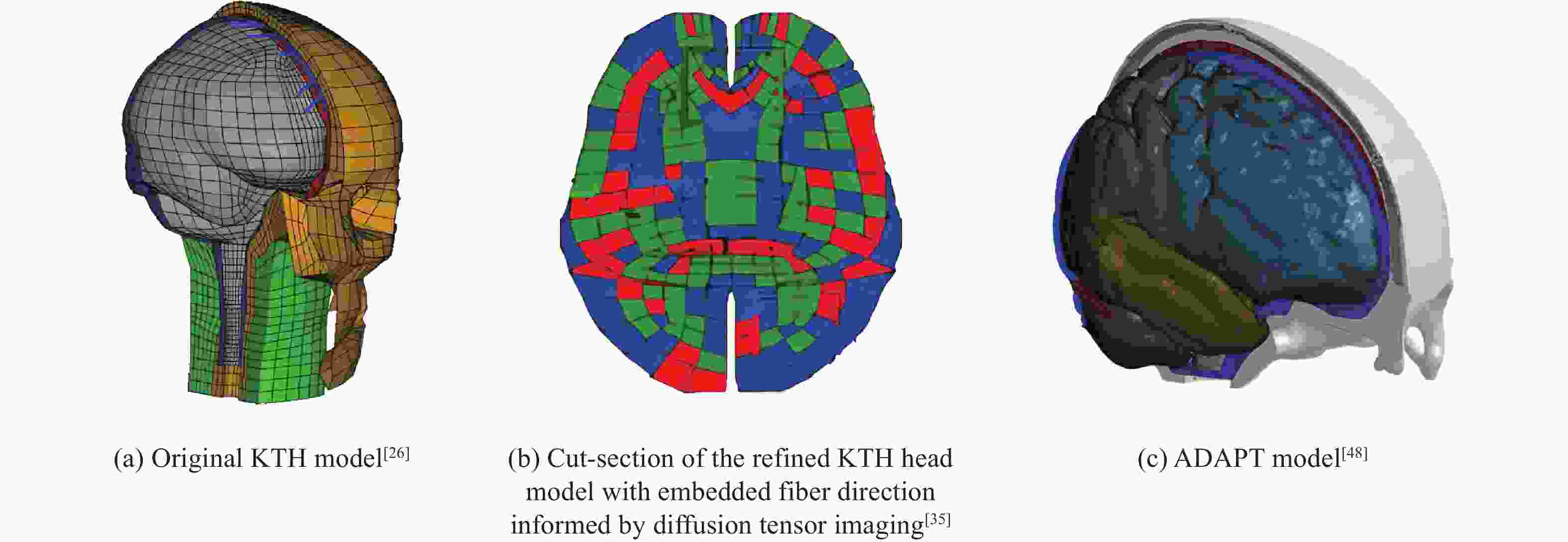
 下载:
下载:
